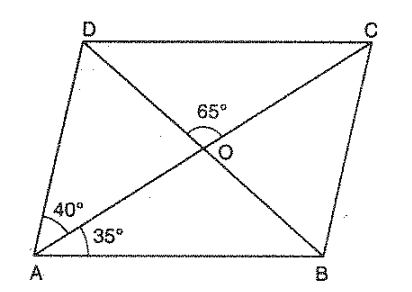The diagonals of a parallelogram ABCD intersect at O . If ∠BOC=900 and ∠BDC=500, then ∠OAB= (a) 400 (b) 500 (c) 100 (d) 900
To find the angle ∠OAB in the parallelogram ABCD where the diagonals intersect at O, we can follow these steps:
Step 1: Identify the given angles
We are given:
- ∠BOC=90∘
- ∠BDC=50∘
Step 2: Use the linear pair property
Since ∠BOC and ∠BOA are on a straight line, they form a linear pair. Therefore, we can write:
∠BOC+∠BOA=180∘
Substituting the known value:
90∘+∠BOA=180∘
To find ∠BOA:
∠BOA=180∘−90∘=90∘
Step 3: Use the property of alternate interior angles
In parallelogram ABCD, the sides AB and CD are parallel, and BD acts as a transversal. Therefore, we can say:
∠BDC=∠CAB
Since ∠BDC=50∘, we have:
∠DBA=50∘
Step 4: Apply the angle sum property in triangle OAB
In triangle OAB, the sum of the angles is equal to 180∘:
∠BOA+∠DBA+∠OAB=180∘
Substituting the known values:
90∘+50∘+∠OAB=180∘
This simplifies to:
140∘+∠OAB=180∘
To find ∠OAB:
∠OAB=180∘−140∘=40∘
Conclusion
Thus, the measure of ∠OAB is 40∘.
Answer
The correct option is (a) 40∘.
---
We are given:
- ∠BOC=90∘
- ∠BDC=50∘
Since ∠BOC and ∠BOA are on a straight line, they form a linear pair. Therefore, we can write:
∠BOC+∠BOA=180∘
Substituting the known value:
90∘+∠BOA=180∘
To find ∠BOA:
∠BOA=180∘−90∘=90∘
In parallelogram ABCD, the sides AB and CD are parallel, and BD acts as a transversal. Therefore, we can say:
∠BDC=∠CAB
Since ∠BDC=50∘, we have:
∠DBA=50∘
In triangle OAB, the sum of the angles is equal to 180∘:
∠BOA+∠DBA+∠OAB=180∘
Substituting the known values:
90∘+50∘+∠OAB=180∘
This simplifies to:
140∘+∠OAB=180∘
To find ∠OAB:
∠OAB=180∘−140∘=40∘
Thus, the measure of ∠OAB is 40∘.
The correct option is (a) 40∘.
Topper's Solved these Questions
Similar Questions
1000 families with 2 children were selected randomly and the following data were recorded.
∣∣∣Number of boys in a family 0 1 2Number of families 140 560 300∣∣∣
If a family is chosen at random, find the probability that it has
(i) no boy
(ii) one boy
(iii) two boys
(iv) at least one boy
(v) at most one boy.
View SolutionIf x=3+√8 , find the value of x2+1x2
View SolutionIn Figure, AOB is a straight line. If ∠AOC+∠BOD=850, then ∠COD= (a)850 (b) 900 (c) 950 (d) 1000
View SolutionIn ABC, if ∠A=1000, AD bisects ∠A and ∠AD ⊥BC . Then, ∠B= 500 (b) 900 (c) 400 (d) 1000
View SolutionLine segments AB and CD intersect at O such that AC∣∣DB. If ∠CAB=450and ∠CDB=550, then ∠BOD= 1000 (b) 800 (c) 900 (d) 1350
View SolutionIn Figure, if EC∣∣AB, ∠ECD=700AND ∠BDO=200 , then ∠OBD is: 200 (b) 500 (c) 600 (d) 700
View SolutionThe diagonals of a rectangle ABCD meet at O . If ∠BOC=44∘, find ∠OAD
View SolutionABCD is a parallelogram in which diagonal AC bisects ∠BAD. If ∠BAC=35∘ , then ∠ABC= 70∘ (b) 110∘ (c) 90∘ (d) 120∘
View SolutionThe diagonals of a parallelogram ABCD intersect at O . If ∠BOC=90∘ and ∠BDC=50∘, then ∠OAB= 40∘ (b) 50∘ (c) 10∘ (d) 900
View SolutionIn Figure, ABCD is a parallelogram in which ∠DAO=400, ∠BAO=350 and ∠COD=650. Find: ∠ABO (ii) ∠ODC (iii) ∠ACB (iv) ∠CBD

View SolutionThe diagonals of a rectangle ABCD meet at O. If ∠BOC=440, find ∠OAD.
View SolutionAOB is a straight line and OC and OD are the two rays on it. If ∠AOC+∠BOD=85∘, then ∠COD=
View SolutionIn △ A B C ,if∠A=1000, AD bisects ∠A and ∠AD ⊥BC . Then, ∠ACD(a)500 (b) 900 (c) 400 (d) 1000
View SolutionLine segments AB and CD intersect at O such that AC=DB. If ∠CAB=450and ∠CDB=550, then ∠BOD= (a)1000 (b) 800 (c) 900 (d) 1350
View SolutionIn Figure, if EC∣∣AB, ∠ECD=700AND ∠BDO=200 , then ∠OBD is: 200 (b) 500 (c) 600 (d) 700
View Solution
